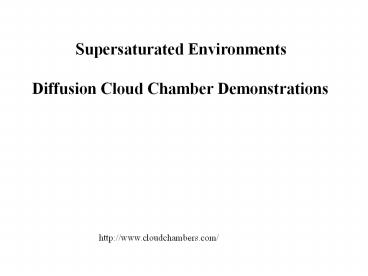Supersaturated Environments - PowerPoint PPT Presentation
Title:
Supersaturated Environments
Description:
Sourcebook on Atomic Energy, Samuel Glasstone (Van Nostrand, 1967). Electrical Coronas, L. L. Loeb (University ... Cosmic Rays, B. B. Rossi (McGraw-Hill, 1964) ... – PowerPoint PPT presentation
Number of Views:30
Avg rating:3.0/5.0
Title: Supersaturated Environments
1
Supersaturated Environments Diffusion Cloud
Chamber Demonstrations
http//www.cloudchambers.com/
2
- Reference List
- Sourcebook on Atomic Energy, Samuel Glasstone
(Van Nostrand, 1967). - Electrical Coronas, L. L. Loeb (University of
California Press, 1965). - Elements of Nuclear Physics, W. E. Meyerhof
(McGraw-Hill, 1967). - Cosmic Rays, B. B. Rossi (McGraw-Hill, 1964).
- Introduction to Nuclear Engineering, J. R.
Lamarsh (Addison-Wesley, 1983). - Cosmic Rays at Ground Level, Wolfendale
(Institute of Physics London, 1973). - An Atlas of Typical Expansion Chamber
Photographs, W. Gentner (Pergamon Press, 1954).
3
Cosmic Ray Shower
This portion of a cosmic ray shower was recorded
in a Supersaturated Environments Cloud Chamber
located near sea level. Note the group of
parallel tracks. It is possible to observe
several such events per hour with our lecture
hall and museum cloud chambers, and record them
on videotape. For further reading about cosmic
ray showers, see Cosmic Rays, by B. B. Rossi
(McGraw-Hill, 1964).
4
Corona Electrode
The electrode on the right is at a positive
potential of about two kilovolts with respect to
the Supersaturated Environments Cloud Chamber
bottom. The electric field at the tip is
sufficient to produce corona ionization. It is
believed that the positive ions reduce the
electric field and ionization, causing the pulsed
cloud of droplets. Pulse frequency is
proportional to electrode potential. For further
reading about corona discharges, see Electrical
Coronas, by L. L. Loeb (University of California
Press, 1965).
5
Low Energy Beta Particles
These low energy beta particle tracks were
recorded in a Supersaturated Environments Cloud
Chamber. Particles emanated from a Carbon-14
source placed at a chamber port located to the
right of photograph field. Trajectories were bent
by the 1000 Gauss magnetic field produced by our
Rare Earth Magnet Assembly. Note the frequent
scattering, as well as the increase in curvature
and ionization per unit length as each particle
is slowed. The maximum particle energy was 156
keV. For further reading about the interaction of
charged particles with matter, see Elements of
Nuclear Physics, by W. E. Meyerhof (McGraw-Hill,
1967).































